新版PEP小学五年级英语下册第一单元教案
- 格式:doc
- 大小:183.50 KB
- 文档页数:13

Unit1 A Let’s talk教案一、教学内容感知Let’s try,理解Let’s talk情境及所包含的文化内涵。
二、教学目标1. 语言知识目标:A. 通过各种课堂活动帮助学生理解和掌握对话中的四会句型When do you finish class in the morning? We finish class at 1 o’clock。
B. 能够利用参考词汇finish class, go back to, classes, start,就学校课程安排进行问答,能在竞争机制环节和教师指令语中理解start, finish和go back to的意思,并能正确发音。
2. 语言技能目标:A. 能够在情景中运用句型When do you …? We … at …o’clock询问并回答某人的日常作息与安排。
B. 能够按照正确的语音、语调、意群朗读对话,并能进行角色表演。
3. 学习策略目标:A. 思维导图记忆和小组合作完成学习任务。
B. 积极用所学语言进行互动交流。
4. 情感态度目标:A. 能够相互了解各自的日常学习生活情况,并对他人询问给予热情的应答。
B. 能够合理地安排日常学习和活动。
C. 能够了解各种职业有不同的作息时间。
5. 文化意识目标:能够了解不同国家人们的作息时间可能不同,不同职业的人作息时间也会有所不同。
三、教学重难点1. 重点:运用句型When do you …? We … at …o’clock.询问并回答某人的日常作息与安排。
2. 难点:能在模拟的情境中运用句型When do you …? We … at …o’clock.进行交际,并使对话达到meaningful, interesting, interactive和natural的特点。
四、教学方法及教具情境教学法,交际法,合作教学法PPT课件,人物头饰,竞争机制图。
五、教学过程Step 1: Greetings(设计意图:与学生问好,拉近与学生的距离。
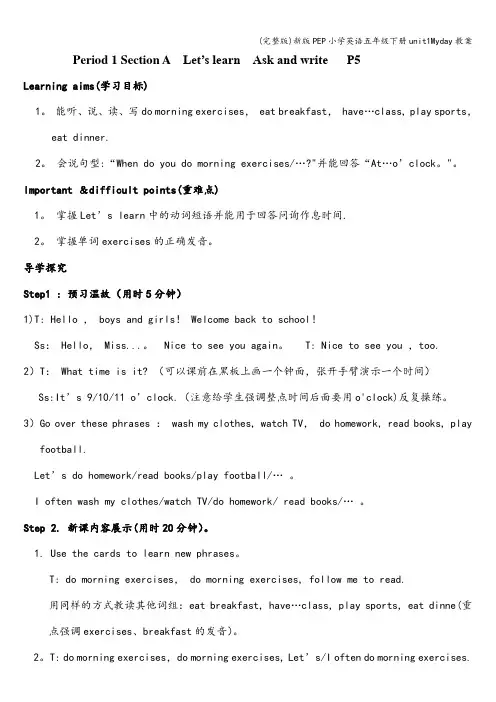
Period 1 Section A Let’s learn Ask and write P5Learning aims(学习目标)1。
能听、说、读、写do morning exercises, eat breakfast,have…class, play sports,eat dinner.2。
会说句型:“When do you do morning exercises/…?"并能回答“At…o’clock。
"。
Important &difficult points(重难点)1。
掌握Let’s learn中的动词短语并能用于回答问询作息时间.2。
掌握单词exercises的正确发音。
导学探究Step1 : 预习温故(用时5分钟)1)T: Hello , boys and girls! Welcome back to school!Ss: Hello, Miss...。
Nice to see you again。
T: Nice to see you ,too.2)T: What time is it? (可以课前在黑板上画一个钟面,张开手臂演示一个时间)Ss:It’s 9/10/11 o’clock.(注意给学生强调整点时间后面要用o'clock)反复操练。
3)Go over these phrases : wash my clothes, watch TV, do homework, read books, play football.Let’s do homework/read books/play football/… 。
I often wash my clothes/watch TV/do homework/ read books/… 。
Step 2. 新课内容展示(用时20分钟)。
1. Use the cards to learn new phrases。
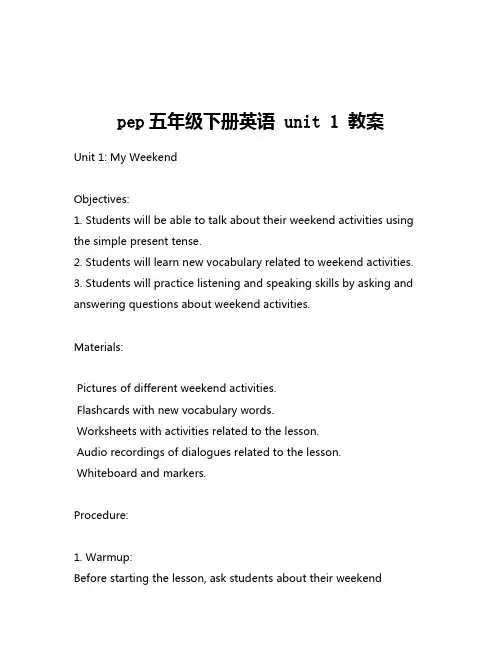
pep五年级下册英语 unit 1 教案Unit 1: My WeekendObjectives:1. Students will be able to talk about their weekend activities using the simple present tense.2. Students will learn new vocabulary related to weekend activities.3. Students will practice listening and speaking skills by asking and answering questions about weekend activities.Materials:Pictures of different weekend activities.Flashcards with new vocabulary words.Worksheets with activities related to the lesson.Audio recordings of dialogues related to the lesson.Whiteboard and markers.Procedure:1. Warmup:Before starting the lesson, ask students about their weekendactivities. Encourage them to share what they did last weekend, what they enjoyed the most, etc. This will help to activate their prior knowledge and get them engaged in the lesson.2. Presentation:Introduce new vocabulary related to weekend activities using flashcards. Pronounce the words clearly and ask the students to repeat after you. Then, show pictures of different weekend activities and ask students to identify the activities by using the new vocabulary words.3. Listening and Speaking:Play an audio recording of a dialogue between two people talking about their weekend activities. Ask students to listen carefully and answer some questions related to the dialogue. Practice some key phrases, such as “What did you do last weekend?” and “I went to the park.”Then, divide the students into small groups and encourage them to practice asking and answering questions about their weekend activities. Give them some prompts such as “Did you go to the park?” or “What did you do on Sunday?” Each student should take turns speaking in their group.4. Consolidation:Give out worksheets with different activities related to the lesson. The worksheets should include exercises for practicing the new vocabulary, using the simple present tense, and answering questions about their weekend activities. Review the worksheets with the students and provide necessary assistance.5. Evaluation:Evaluate the students' learning by observing their performance during the speaking and listening activities and checking their written exercises.6. Homework:Assign homework related to the lesson, such as writing a short paragraph about their weekend activities using the simple present tense. Encourage the students to use the new vocabulary words while writing.7. Conclusion:Summarize the lesson by reviewing the vocabulary words, new phrases, and grammar structures introduced in the lesson. Also, provide feedback on the student's performance and encourage them to keep practicing.。
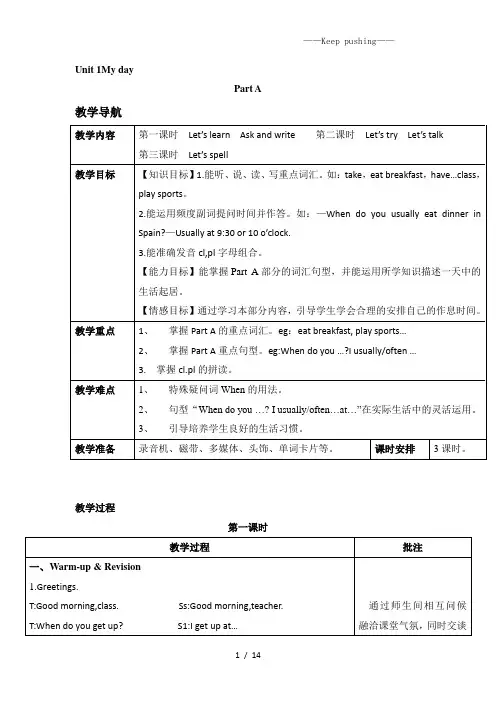
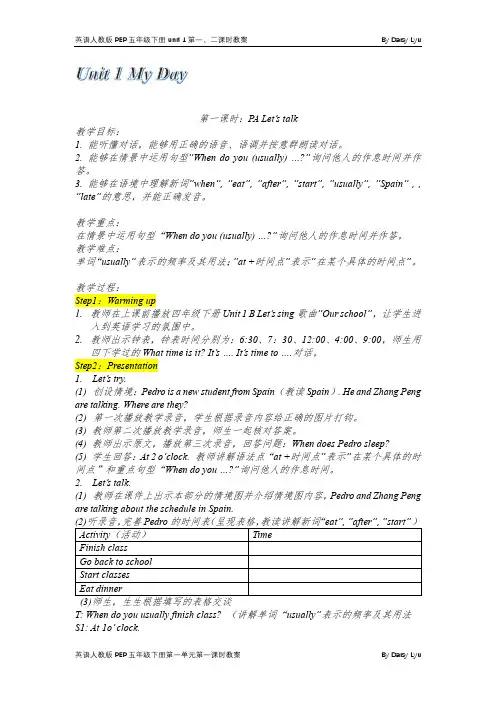
第一课时:P A Let’s talk教学目标:1. 能听懂对话,能够用正确的语音、语调并按意群朗读对话。
2. 能够在情景中运用句型“When do you (usually) …?”询问他人的作息时间并作答。
3. 能够在语境中理解新词“when”, “eat”, “after”, “start”, “usually”, “Spain” , , “late”的意思,并能正确发音。
教学重点:在情景中运用句型“When do you (usually) …?”询问他人的作息时间并作答。
教学难点:单词“usually”表示的频率及其用法;“at +时间点”表示“在某个具体的时间点”。
教学过程:Step1:Warming up1.教师在上课前播放四年级下册Unit 1 B Let’s sing歌曲“Our school”,让学生进入到英语学习的氛围中。
2.教师出示钟表,钟表时间分别为:6:30、7:30、12:00、4:00、9:00,师生用四下学过的What time is it? It’s …. It’s time to ….对话。
Step2:Presentation1.Let’s try.(1)创设情境:Pedro is a new student from Spain(教读Spain). He and Zhang Peng are talking. Where are they?(2)第一次播放教学录音,学生根据录音内容给正确的图片打钩。
(3) 教师第二次播放教学录音,师生一起核对答案。
(4) 教师出示原文,播放第三次录音,回答问题:When does Pedro sleep?(5) 学生回答:At 2 o’clock. 教师讲解语法点“at +时间点”表示“在某个具体的时间点”和重点句型“When do you …?”询问他人的作息时间。
2.Let’s talk.(1)教师在课件上出示本部分的情境图并介绍情境图内容,Pedro and Zhang Peng are talking about the schedule in Spain.T: When do you usually finish class? (讲解单词“usually”表示的频率及其用法S1: At 1o’ clock.T: When do you usually eat dinner?S2: At 9:30 or 10 o’clock.T: That’s too late. (教读讲解“late”的意思)Step3:Practice1. 学生跟读录音。
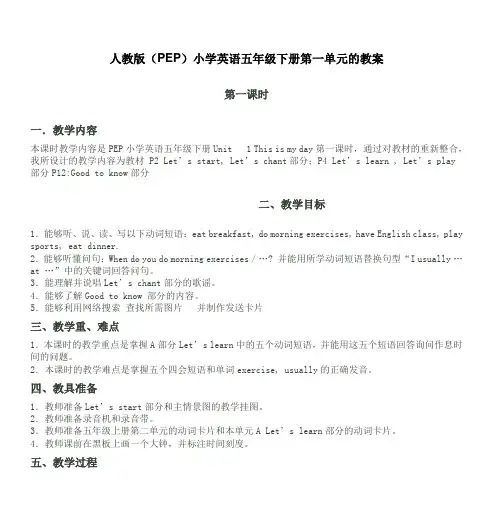
人教版(PEP)小学英语五年级下册第一单元的教案第一课时一.教学内容本课时教学内容是PEP小学英语五年级下册Unit 1 This is my day第一课时,通过对教材的重新整合,我所设计的教学内容为教材P2 Let’s start, Let’s chant部分;P4 Let’s learn , Let’s play部分P12:Good to know部分二、教学目标1.能够听、说、读、写以下动词短语:eat breakfast, do morning exercises, have English class, play sports, eat dinner.2.能够听懂问句:When do you do morning exercises / …? 并能用所学动词短语替换句型“I usually … at …”中的关键词回答问句。
3.能理解并说唱Let’s chant部分的歌谣。
4.能够了解Good to know 部分的内容。
5.能够利用网络搜索查找所需图片并制作发送卡片三、教学重、难点1.本课时的教学重点是掌握A部分Let’s learn中的五个动词短语,并能用这五个短语回答询问作息时间的问题。
2.本课时的教学难点是掌握五个四会短语和单词exercise, usually的正确发音。
四、教具准备1.教师准备Let’s start部分和主情景图的教学挂图。
2.教师准备录音机和录音带。
3.教师准备五年级上册第二单元的动词卡片和本单元A Let’s learn部分的动词卡片。
4.教师课前在黑板上画一个大钟,并标注时间刻度。
五、教学过程Step I Warm- up(热身)1. 师生同颂教材P2 中Let’s chant部分歌谣。
What do you do on the weekend?I usually go swimming.Sometimes I climb mountains.Sometimes I go shopping.What do you do on the weekend?I usually play the piano.Sometimes I visit grandparents,Sometimes I watch videos.(设计意图:通过琅琅上口的儿歌,帮助学生回忆所学日常生活的短语和副词Sometimes, usually的用法,为本课新授做好铺垫。
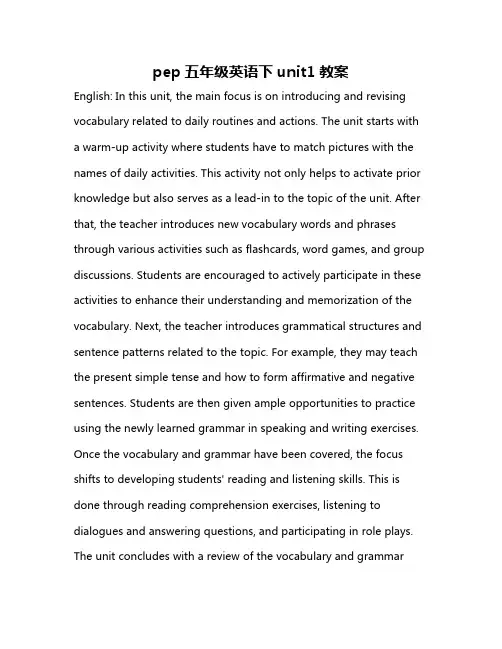
pep五年级英语下unit1教案English: In this unit, the main focus is on introducing and revising vocabulary related to daily routines and actions. The unit starts with a warm-up activity where students have to match pictures with the names of daily activities. This activity not only helps to activate prior knowledge but also serves as a lead-in to the topic of the unit. After that, the teacher introduces new vocabulary words and phrases through various activities such as flashcards, word games, and group discussions. Students are encouraged to actively participate in these activities to enhance their understanding and memorization of the vocabulary. Next, the teacher introduces grammatical structures and sentence patterns related to the topic. For example, they may teach the present simple tense and how to form affirmative and negative sentences. Students are then given ample opportunities to practice using the newly learned grammar in speaking and writing exercises. Once the vocabulary and grammar have been covered, the focus shifts to developing students' reading and listening skills. This is done through reading comprehension exercises, listening to dialogues and answering questions, and participating in role plays. The unit concludes with a review of the vocabulary and grammarlearned throughout the unit, allowing students to consolidate their knowledge and assess their understanding. Throughout the unit, the teacher provides guidance and support, ensuring that students are actively engaged in the learning process. By the end of the unit, students should be able to confidently use the vocabulary and grammar structures in everyday conversations.中文翻译: 在这个单元中,重点是介绍和复习与日常生活和行为相关的词汇。

人教版(PEP)小学英语五年级下册第一单元教案1)掌握四季的单词和季节性活动的单词和短语。
2)掌握询问所喜欢的季节及其原因的句型。
3)了解字母组合air。
ear在单词中的发音以及sp。
sk的发音规律。
4)培养基本的阅读和写作技能,如快速查找关键信息和规范书写。
3.情感态度目标:1)培养学生对季节变化的兴趣和好奇心。
2)增强学生的交流能力和自信心。
3)培养学生良好的研究惯和写作惯。
4)鼓励学生积极参与课堂活动,增强研究的主动性和积极性。
Unit 2 ___Topic: Discussing favorite seasonsLanguage systems:1.Vocabulary: Master the four seasons: spring。
summer。
fall。
winter。
season。
seasonal activities words and phrases: swim。
fly kites。
skate。
make a snowman。
plant trees。
sleep.2.Grammar: ___: What’s your favorite seas on。
Which season do you like best。
Why do you like it?3.n: Learn to ___.4.Phonology: Practice ___。
ear in words and the ___ sp。
___.Language skills:1.Listening: Understand some single sentences。
dialogues。
___.2.Speaking: ___.3.Reading: Understand dialogues or short texts and develop some basic reading skills。
such as how to quickly find key n and guess words based on context.4.Writing: Write four-word words and ___.Objectives:1.Ability objectives:1) ___ and reasons。
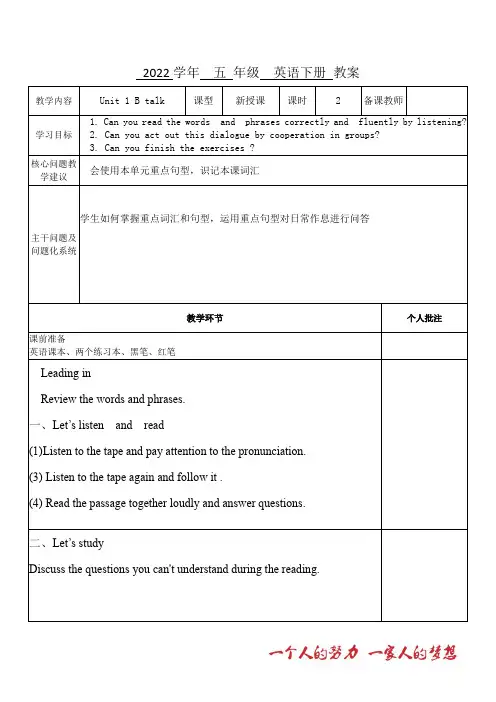
2022学年五年级英语下册教案教学内容Unit 1 B talk 课型新授课课时 2 备课教师学习目标1. Can you read the words and phrases correctly and fluently by listening?2. Can you act out this dialogue by cooperation in groups?3. Can you finish the exercises ?核心问题教学建议会使用本单元重点句型,识记本课词汇主干问题及问题化系统学生如何掌握重点词汇和句型,运用重点句型对日常作息进行问答教学环节个人批注课前准备英语课本、两个练习本、黑笔、红笔Leading inReview the words and phrases.一、Let’s listen and read(1)Listen to the tape and pay attention to the pronunciation.(3) Listen to the tape again and follow it .(4) Read the passage together loudly and answer questions.二、Let’s studyDiscuss the questions you can't understand during the reading.三、Let’s talkMake some new sentences using the key sentences and role play..四、Let’s practice一、英译汉st night _________2. on the weekend _______2. 3. watch TV _________ 4. play ping-pong _______3.5. play music _________ 6. go shopping ________二、连词成句1. father, I, with, play, my, basketball, often (.)2. fun, like, that, a, of, sounds, lot (.)3. weekend, do, what, you, the, do, on (?)教学反思。

五年级下册英语第一单元教案五年级下册英语第一单元教案(通用5篇)作为一名教职工,有必要进行细致的教案准备工作,借助教案可以提高教学质量,收到预期的教学效果。
那么问题来了,教案应该怎么写?下面是小编整理的五年级下册英语第一单元教案,仅供参考,希望能够帮助到大家。
五年级下册英语第一单元教案篇1教学目标:1.知识与能力技能目标(1)掌握生词: lay , caterpillar , become .(2)读懂语篇,学习蝴蝶的有关知识。
2. 过程与方法目标在自主与合作交流的学习过程中,感受蝴蝶蜕变的美,学习有关蝴蝶的知识3.情感态度价值观目标培养学生热爱自然的美好情感;激发学生的探知热情,让学生体验合作的愉快,培养学生的创造力与想象力以及跨学科学习的能力。
教学重点:帮助学生读懂语篇。
教学难点:使学生能用英语讲述蝴蝶的生长过程以及介绍蝴蝶的有关知识。
教具准备:课件、录音带、蝴蝶蜕变过程视频教学过程:一、自主式导读Warming up:T: Nice to meet you ! Do you like insects ? Whichinsect do you know?Ss: ants, ladybirds, flies, butterflies…T: Among all the insects, which one is the most beautiful?S1: Butterflies.T: Yes , butterflies are one of the most beautiful insect in the world. Ihave some pictures about butterflies . Do you want to have a look ?In this lesson we are going to talk about butterflies.板书课题Module4Unit2 Butterflies(学生齐读课题)出示学习目标:(齐读学习目标,明确本节课的学习目的)1、我能听所读写单词: lay , caterpillar ,become .2、我能读懂语篇,学习蝴蝶的有关知识。
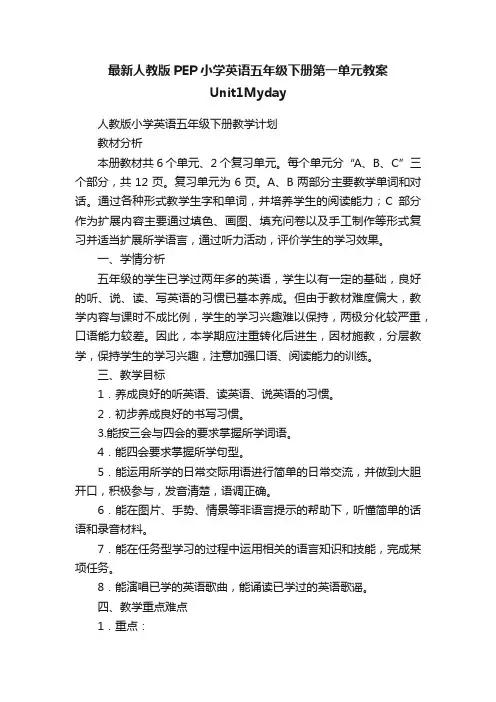
最新人教版PEP小学英语五年级下册第一单元教案Unit1Myday人教版小学英语五年级下册教学计划教材分析本册教材共6个单元、2个复习单元。
每个单元分“A、B、C”三个部分,共12页。
复习单元为6页。
A、B两部分主要教学单词和对话。
通过各种形式教学生字和单词,并培养学生的阅读能力;C部分作为扩展内容主要通过填色、画图、填充问卷以及手工制作等形式复习并适当扩展所学语言,通过听力活动,评价学生的学习效果。
一、学情分析五年级的学生已学过两年多的英语,学生以有一定的基础,良好的听、说、读、写英语的习惯已基本养成。
但由于教材难度偏大,教学内容与课时不成比例,学生的学习兴趣难以保持,两极分化较严重,口语能力较差。
因此,本学期应注重转化后进生,因材施教,分层教学,保持学生的学习兴趣,注意加强口语、阅读能力的训练。
三、教学目标1.养成良好的听英语、读英语、说英语的习惯。
2.初步养成良好的书写习惯。
3.能按三会与四会的要求掌握所学词语。
4.能四会要求掌握所学句型。
5.能运用所学的日常交际用语进行简单的日常交流,并做到大胆开口,积极参与,发音清楚,语调正确。
6.能在图片、手势、情景等非语言提示的帮助下,听懂简单的话语和录音材料。
7.能在任务型学习的过程中运用相关的语言知识和技能,完成某项任务。
8.能演唱已学的英语歌曲,能诵读已学过的英语歌谣。
四、教学重点难点1.重点:①四会句型、单词。
②在任务型学习的过程中运用相关的语言知识和技能,完成某项任务。
③运用所学的日常交际用语进行简单的日常交流,并做到大胆开口,积极参与,发音清楚,语调正确。
2.难点:养成良好的听英语、读英语、说英语的习惯。
五、主要措施1.根据学生的年龄特征,充分利用直观教具和电教手段,创设良好的语言氛围,调动学生的学习积极性。
2.在教学过程中,采用情景教学法,让学生身临其境,积极主动地参与到课堂教学中去,调动学生的非智力因素,提高学生实际运用语言的能力。
Unit 1 This is My Day第一课时一、教学目标与要求1、能够听、说、读、写以下动词短语:eat breakfast , do morning exercises , have English class , play sports , eat dinner .2、能够听懂问句:When do you do morning exercises/……并能用所学动词短语替换句型“I usually …at…”中的关键词回答问句。
3、能够理解并说唱Let’s chant 部分的歌谣。
4、能够了解Good to know 部分的内容。
二、教学重点、难点1、重点是掌握A 部分中的五个动词短语,并能用这些回答询问作息时间的问题。
2、难点是exercises , ususlly 的发音。
三、课前准备1、录音机和相关的录音带2、五个动词短语的教学卡片四、教学步骤1、热身(1)对话练习:询问时间What time is it now ? It’s ……(2)复习五年级第一学期所学的一些动词,如:cook the meals , wash clothes 等。
2、新课呈现(1)游戏:Guess! What am I doing ? 引出新动词词组:do morning exercise , have English class , eat breakfast , eat dinner , play sport ?(2)利用chant 对学生进行巩固练习What can you do ? I can do morning exercises .What can you do ? I can ……(3)在黑板上画一口钟,标出时间。
教师:I do morning exercises at 7:00 . What about you ?(4)让学生根据自己的时间,对刚刚所学的动词短语进行练习。
(5)教师在学生口述的时候,可以不失时机地加问:When do you ……?(6)介绍新单词:usually ,并运用到句子中:I usually ……(7)组织学生模仿Let’s learn 进行对话。
Unit1 My day第一课时知识目标:1.能够听、说、读、写以下动词短语:eat breakfast, do morning exercises, have…class, play sports, eat dinner.2.能够听懂问句:When do you do morning exercises / …? 并能用所学动词短语替换句型―At…‖中的关键词回答问句。
能力目标:能理解并跟唱Let’s sing 的歌谣。
情感目标:能够合理安排日常学习和周末活动。
教学重点:掌握A 部分Let’s learn 中的五个动词短语,并能用这五个短语回答询问作息时间的问题。
教学难点:掌握五个四会短语和单词exercises 的正确发音。
教学准备:课件、单词图片教学方法:情景教学法、TPR 教学法Preparation—准备活动1.Let’s sing《Ten candles》,听并跟唱三年级上册第六单元歌曲复习数字,为本节课时间表达做铺垫。
2.Free talk:复习上节课重点内容。
S1:When do you get up?S2:I get up at 5 o’clock. S1: When do you…? S2: I…at…o’clock. Presentation—新知呈现1.由Free talk 环节自然引入Pedro 的时间安排,T:How about Pedro’s schedule? Let’s watch together.利用PPT 出示本课Let’s learn 内容,请学生仔细观察,猜测词组意思,并鼓励生大胆说出学过的或认识的单词。
Eg: do, morning, have, class, play, dinner. 2.师根据学生记忆规律,由易到难,打破顺序,组合讲解:①have English class have Chinese class have PE class…②play football play basketball ③tea read peach eat breakfast fast play sports horse fork 辅助记忆break(head) have …class 并举例拓展。
小学英语五年级下册《Unit 1 My day》教学设计(人教PEP版)一、教学目标1. 知识目标•学习并掌握My day这一话题中的词汇及短语,如:get up, have breakfast, brush teeth, go to school, have lunch, do homework, watch TV, go to bed等。
•了解和描述一般现在时的基本语法结构及其用法。
•学会问答与日常生活有关的基本问题。
2. 能力目标•提高学生听、说、读、写英语的能力,特别是口语表达和听力理解的能力。
•培养学生的英语学习兴趣,激发学习英语的热情。
•培养学生的自我管理和合作精神,帮助学生形成良好的学习习惯。
3. 情感目标•培养学生爱学习的态度,乐观向上的心态。
•培养学生与他人进行良好的交流和合作的能力,帮助学生形成良好的自我形象。
二、教学重难点1. 教学重点•My day话题中的词汇及短语。
•基本的一般现在时的语法结构及其用法。
•能够问答与日常生活有关的基本问题。
2. 教学难点•能够正确运用一般现在时谈论自己的日常活动。
•培养语音语调,以及口语表达和听力理解的能力。
三、教学过程1. 导入新课(10分钟)•利用图片引出话题:My day。
•让学生通过图片描述“洗脸”、“刷牙”等日常活动,引导学生进入Myday这一话题。
•引导学生回答问题:“What do you usually do in the morning?”2. 新课讲解(30分钟)•通过图片和语音练习帮助学生学习词汇及短语,如:get up, have breakfast, brush teeth, go to school, have lunch, do homework, watch TV, go to bed等。
•通过示范和训练,教授一般现在时的语法结构及其用法,包括:主语+动词原形+其他,例如:I get up at six o’clock. He goes to school by bus. They have lunch at noon.等。
五年级下册英语人教版第一单元教案(精选8篇)五年级英语下册第一单元的教案篇一一、教法建议本单元主要内容是让学生能听、说、读、写四会,掌握从A到N14个英语字母,并能正确辨认其中的三个元音字母,即Aa,Ee,Ii。
能认读其印刷体和手写体字母的大小写形式,注意书写格式、笔划、笔顺合乎标准,培养学生良好的书写习惯。
【抛砖引玉】1.英语字母教学是入门阶段的一项主要的教学内容,为了使字母教学任务顺利完成,应通过看、听、说、练四个方面解决。
(1)看是指看老师口型,善于模仿教师发音。
(2)听是指听录音学字母,对初学者来说Cc,Gg和Jj是比较难读准的,因此应仔细去听。
(3)说是指实践,即通过听、看过程使学生达到独立地、正确地读出字母。
(4)练是指通过看、听、说的反复训练,善于发现错误并及时纠正。
2.积极创设语境,培养学生交际能力。
(1)本单元的口语训练主要围绕Greeting展开教学,教师应引导学生运用Hello! What‘s your name? My name is...进行会话。
(2)教师以身示范,亲切地向学生打招呼,尽量给学生创造英语情景,如:Hello!或Good morning, My mane is Lin Lina. What’s your name? How are you?等,通过语言交流方式,培养学生的语言表达能力。
(3)运用TPR(Total Physical Response)培养学生反应能力和语言感知能力。
如:Stand up! sit down, please. Listen to me. Open your books. Close your books 等课堂用语,教师可用手势表明其含义。
学生听懂后,会迅速做出正确反应。
(4)使用pair work培养学生自我展示能力。
【指点迷津】本单元难点知识1.字母的书写格式。
对初学者来讲,小学的汉语拼音对学习英语字母有一定的干扰。
应引导学生仔细观察14个字母的大小写格式,避免书写错误,做到书写正确、美观。